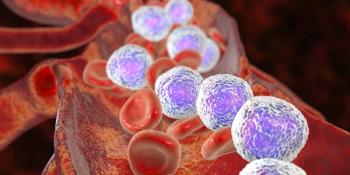
Testing and Treatment Patterns Rapidly Changing in CLL
Testing patterns associated with the diagnosis and treatment of chronic lymphocytic leukemia have changed rapidly during the last decade.
Testing patterns associated with the diagnosis and treatment of chronic lymphocytic leukemia (CLL) have changed rapidly during the last decade, according to a new study published in Cancer.
There have been significant increases in the use of fluorescence in situ hybridization (FISH) testing, immunoglobulin heavy-chain variable region gene (IgVH)-mutation analyses, and lymph node biopsies.
“Given the rapid therapeutic developments in CLL, we anticipate dynamic changes in its future treatment patterns, and possibly therapies emerging free from standard chemotherapy,” wrote Erlene K. Seymour, MD, of Karmanos Cancer Institute, Wayne University, and colleagues. “Fully evaluating the use of these therapies by practice type, and the access to these therapies among different patient populations, will be a vital focus of future studies.”
Seymour and colleagues
The use of FISH within 2 years of diagnosis increased from about 44% of all patients diagnosed in 2008 to 51% in 2014 (P = .003). Among patients diagnosed and treated, FISH was used within 2 years in 53.4% of patients in 2008 and 61.6% of those treated in 2014. The study showed that older patients and those on Medicare without private insurance were less likely to undergo FISH testing in 2014.
The rate of IgVH-mutation analysis also increased, but was still used infrequently (6% in 2008 vs 11% in 2014). In addition, the rate of lymph node biopsies was only 5% in 2008 but increased to 27% in 2014 (P < .001). However, the researchers observed a significant decrease in the use of bone marrow biopsies during the study period, from 46% of patients in 2008 to 39% in 2014 (P = .002).
“Despite this increase in testing, there remains a significant number of patients who do not undergo FISH and/or IgVH-mutation status testing prior to initiation of therapy,” the researchers wrote.
Finally, the researchers found that there were differences in treatments over time. In 2008, fludarabine, cyclophosphamide, and rituximab (FCR) was the most commonly used treatment, followed by rituximab monotherapy, fludarabine and rituximab, and chlorambucil-based therapy. By 2014, the most common treatment was bendamustine/rituximab, followed by rituximab monotherapy, FCR, and ibrutinib.
Alessandra Ferrajoli, MD, of the department of leukemia at University of Texas MD Anderson Cancer Center, told Cancer Network that is it encouraging to see more testing for prognostic and predictive factors.
“FISH, IgVH-mutational status, and assessment of TP53 status should be always performed before treatment (first or subsequent line of therapy),” Ferrajoli said. “It is unfortunate to see that this is not done as frequently in older patients and patients without private insurance coverage, because these factors are important in all patients.”
Newsletter
Stay up to date on recent advances in the multidisciplinary approach to cancer.

















































































